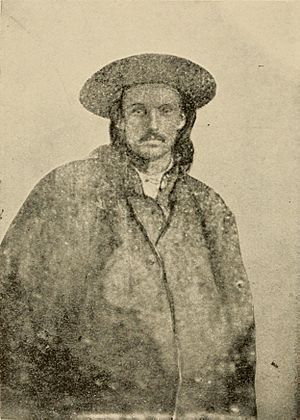Henry C. Magruder facts for kids
Quick facts for kids
Henry C. McGruder
|
|
|---|---|
 |
|
| Born | 1844 |
| Died | October 20, 1865 (aged 21) Louisville, Kentucky, U.S.
|
| Cause of death | Execution by hanging |
| Known for | Confederate guerilla fighter and war criminal |
| Criminal status | Executed |
| Conviction(s) | Acting as a guerilla |
| Criminal penalty | Death |
Henry C. Magruder (1844 – October 20, 1865) was a soldier for the Confederate States during the American Civil War. He was also known as a guerrilla fighter. Born in Bullitt County, Kentucky, he fought in several big battles in the western part of the war. He is remembered for his time as a guerrilla. Some people think he might have inspired a famous fictional character named Sue Munday, a local folk hero and guerrilla.
Henry C. Magruder's Military Path
Magruder joined the Confederate States Army when he was 17 years old. He served under General Simon Bolivar Buckner at the Battle of Fort Donelson. He was captured when the fort surrendered. But he managed to escape soon after.
Magruder then joined the personal guards of Confederate General Albert Sidney Johnston. He served with General Johnston at the Battle of Shiloh. After General Johnston died, Magruder moved to General John Hunt Morgan's Kentucky Cavalry. He took part in Morgan's Raid into Ohio and Indiana. He escaped capture again during this raid. He was able to cross the Ohio River and get back to Kentucky.
Life as a Guerrilla Fighter
Once Magruder was back in Kentucky, behind Union lines, he found other escaped Confederates. He led them in attacks against Union military targets south of Louisville.
Magruder's small group was ambushed by pro-Union home guards. Most of his group were captured after robbing a bank in February 1865. Magruder and two other men avoided capture for a few weeks. But they were eventually found in a barn and had to surrender. Magruder was seriously hurt during this event.
One of the men captured with Magruder was Marcellus Jerome Clarke. Clarke was quickly charged with being a guerrilla. He was found guilty by a military court and died in March 1865. Magruder was allowed to get better in jail before his own trial.
The Sue Mundy Legend
Before Magruder's trial, a publisher in Louisville, Kentucky named George D. Prentice wrote articles about guerrilla activity. He wrote about these events in his newspaper, Louisville Journal. But he said the actions were done by a person called "Sue Mundy." These stories were very similar to what Clarke and Magruder had done.
Some people believe Magruder was the real person who inspired the made-up Confederate guerrilla fighter, Sue Mundy. Magruder himself said this in a book published after his death. The book was called Three Years in the Saddle: The Life and Confession of Henry Magruder: The Original Sue Munday, The Scourge of Kentucky (1865).

